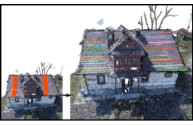Seed point set-based building roof extraction from airborne LiDAR point clouds using a top-down strategy
Jie Shao (1,3), Wuming Zhang (1,2), Aojie Shen (4), Nicolas Mellado (3), Shangshu Cai (4), Lei Luo (5), Nan Wang (6), Guangjian Yan (4), Guoqing Zhou (7)
(1) School of Geospatial Engineering and Science, Sun Yat-Sen University, China
(2) Southern Marine Science and Engineering Guangdong Laboratory, China
(3) IRIT, CNRS, University of Toulouse, France
(4) State Key Laboratory of Remote Sensing Science, Beijing Normal University, China
(5) Key Laboratory of Digital Earth Science, Chinese Academy of Sciences, Beijing, China
(6) School of Geography and Tourism, Anhui Normal University, China
(7) Guangxi Key Laboratory of Spatial Information and Geomatics, Guilin University of Technology, China
Automation in Construction, Elsevier, 2021, 126
Building roof extraction from airborne laser scanning point clouds is significant for building modeling. The common method adopts a bottom-up strategy which requires a ground filtering process first, and the subsequent process of region growing based on a single seed point easily causes oversegmentation problem. This paper proposes a novel method to extract roofs. A top-down strategy based on cloth simulation is first used to detect seed point sets with semantic information; then, the roof seed points are extracted instead of a single seed point for region-growing segmentation. The proposed method is validated by three point cloud datasets that contain different types of roof and building footprints. The results show that the top-down strategy directly extracts roof seed point sets, most roofs are extracted by the region-growing algorithm based on the seed point set, and the total errors of roof extraction in the test areas are 0.65%, 1.07%, and 1.45%. The proposed method simplifies the workflow of roof extraction, reduces oversegmentation, and determines roofs in advance based on the semantic seed point set, which suggests a practical solution for rapid roof extraction.
Bibtex
@article{SHAO2021103660,
title = {Seed point set-based building roof extraction from airborne LiDAR point clouds using a top-down strategy},
journal = {Automation in Construction},
volume = {126},
pages = {103660},
year = {2021},
issn = {0926-5805},
doi = {https://doi.org/10.1016/j.autcon.2021.103660},
url = {https://www.sciencedirect.com/science/article/pii/S0926580521001114},
author = {Jie Shao and Wuming Zhang and Aojie Shen and Nicolas Mellado and Shangshu Cai and Lei Luo and Nan Wang and Guangjian Yan and Guoqing Zhou}
}

